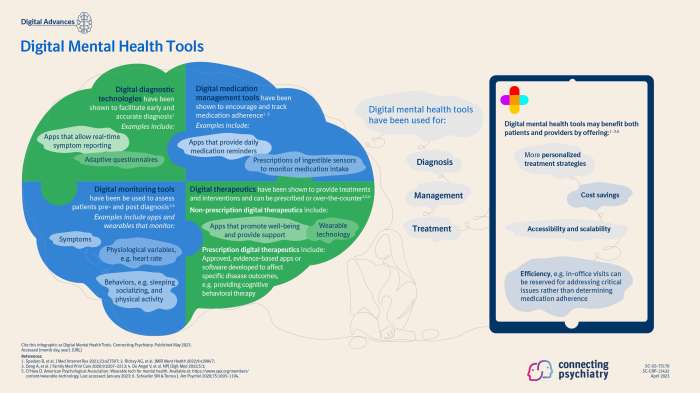How Psychiatry Is Evolving with Digital Therapy Tools: A Modern Approach to Mental Health Care

Exploring the evolution of psychiatry through the lens of digital therapy tools sheds light on the innovative ways in which mental health care is being revolutionized. From traditional methods to cutting-edge technological solutions, this topic delves into the dynamic landscape of modern psychiatry.
As we navigate through the different aspects of this transformation, it becomes evident how digital tools are reshaping the way we approach mental health treatment and care.
Overview of Psychiatry Evolution
In the past, traditional therapy methods in psychiatry primarily involved face-to-face sessions between patients and mental health professionals. These sessions often relied on talk therapy, medication management, and other conventional approaches to treat various mental health conditions.
However, with the advancement of technology and the increasing use of digital tools in healthcare, there has been a noticeable shift towards incorporating digital therapy tools in modern psychiatry. These tools include virtual therapy platforms, mobile applications, wearable devices, and online support groups that aim to provide more accessible and convenient mental health support to individuals.
Benefits of Integrating Technology into Psychiatric Treatment
- Increased Access to Care: Digital therapy tools allow individuals to receive mental health support from the comfort of their own homes, overcoming barriers such as transportation issues or limited availability of mental health professionals.
- Personalized Treatment Plans: Technology enables the customization of treatment plans based on individual needs and preferences, leading to more personalized and effective care.
- Remote Monitoring: With digital tools, mental health professionals can remotely monitor patients' progress, track symptoms, and provide timely interventions when needed.
- Reduced Stigma: Online therapy platforms and virtual support groups provide a level of anonymity that may reduce the stigma associated with seeking mental health treatment, encouraging more individuals to seek help.
- Enhanced Engagement: Interactive features in digital therapy tools can increase patient engagement and motivation, leading to better treatment outcomes.
Types of Digital Therapy Tools
Digital therapy tools have revolutionized the field of psychiatry by providing innovative ways to deliver mental health care. These tools encompass a wide range of technologies that cater to different needs and preferences of patients.
Mobile Apps
Mobile apps are one of the most widely used digital therapy tools in psychiatry. These apps offer a variety of features such as mood tracking, mindfulness exercises, cognitive-behavioral therapy (CBT) modules, and virtual therapy sessions. Patients can access these apps anytime, anywhere, making it convenient for them to manage their mental health.
Virtual Reality
Virtual reality (VR) therapy has gained popularity in treating anxiety disorders, phobias, and post-traumatic stress disorder (PTSD). By exposing patients to virtual environments that simulate their fears or triggers, VR therapy helps them confront and manage their symptoms in a controlled setting.
It provides a safe and immersive experience for patients undergoing exposure therapy.
Telepsychiatry
Telepsychiatry involves delivering mental health services remotely through video conferencing or phone calls. This digital therapy tool enhances access to care for patients in rural or underserved areas, eliminates barriers such as transportation and stigma, and allows for greater flexibility in scheduling appointments.
Telepsychiatry has been particularly effective during the COVID-19 pandemic when in-person visits were limited.
Comparing Effectiveness
Each type of digital therapy tool has its unique strengths and limitations in treating mental health conditions. While mobile apps offer convenience and self-guided interventions, virtual reality provides immersive exposure therapy experiences, and telepsychiatry improves access to care for underserved populations.
The effectiveness of these tools ultimately depends on the individual patient's needs, preferences, and the nature of their mental health condition.
Successful Case Studies
Several studies have demonstrated the positive impact of digital therapy tools on patient outcomes. For example, a study published in the Journal of Medical Internet Research showed that patients using a mindfulness meditation app experienced a significant reduction in anxiety and depression symptoms.
Another study found that virtual reality exposure therapy was effective in reducing PTSD symptoms in war veterans. These successful case studies highlight the potential of digital therapy tools in improving mental health outcomes.
Impact on Patient Care
Digital therapy tools have revolutionized the landscape of mental health services by significantly enhancing accessibility for patients in need. These tools have bridged the gap between patients and mental health professionals, offering a convenient and efficient way to seek support and treatment.
Enhanced Accessibility to Mental Health Services
- Patients can now access therapy sessions from the comfort of their own homes, eliminating barriers such as transportation issues or geographical limitations.
- Individuals in remote or underserved areas can now receive timely mental health support through online platforms and apps.
- Digital tools have reduced waiting times for appointments, allowing patients to receive immediate assistance during critical moments.
Monitoring Patient Progress and Providing Real-Time Feedback
- Digital therapy tools enable mental health professionals to track patient progress more effectively through data analytics and monitoring features.
- Real-time feedback mechanisms in these tools help therapists adjust treatment plans promptly based on the patient's responses and outcomes.
- Patient data collected by these tools can provide valuable insights into treatment effectiveness and help personalize therapy approaches.
Challenges and Limitations Faced by Patients Using Digital Therapy Tools
- Some patients may struggle with the lack of in-person interaction and personalized attention that traditional therapy offers.
- Technological barriers, such as poor internet connectivity or limited access to devices, can hinder patients from fully engaging with digital therapy tools.
- Privacy concerns related to sharing sensitive information online may deter certain individuals from utilizing these platforms for mental health support.
Ethical and Legal Considerations

The integration of digital therapy tools in psychiatry raises several important ethical and legal considerations that must be carefully addressed to ensure the well-being of patients and the effectiveness of treatment.
Patient Privacy and Data Security
Ensuring patient privacy and data security is paramount when utilizing digital therapy tools in mental health interventions. Patients must have confidence that their personal information is protected and that their data is not vulnerable to breaches or misuse. It is essential for healthcare providers to implement robust security measures, encryption protocols, and strict access controls to safeguard sensitive patient data from unauthorized access.
Regulatory Landscape
The regulatory landscape governing the use of digital tools in mental healthcare is constantly evolving to keep pace with technological advancements. Healthcare providers must adhere to stringent regulations and standards to ensure the ethical and legal use of digital therapy tools.
Regulatory bodies such as the FDA in the United States and similar agencies worldwide play a crucial role in evaluating and approving digital mental health interventions to guarantee their safety, efficacy, and compliance with ethical standards.
Closing Notes
In conclusion, the integration of digital therapy tools in psychiatry marks a significant milestone in the field of mental health care. By embracing technology and innovation, we pave the way for a more accessible, efficient, and patient-centered approach to addressing mental health challenges.
FAQ Summary
How can digital therapy tools improve patient outcomes?
Digital therapy tools can enhance patient outcomes by providing real-time feedback, monitoring progress, and increasing accessibility to mental health services.
What are some examples of successful case studies using digital therapy tools?
Successful case studies have shown improvements in patient outcomes using mobile apps for cognitive behavioral therapy and virtual reality for exposure therapy.
What ethical considerations should be taken into account when using digital therapy tools in psychiatry?
Ethical considerations include ensuring patient privacy, data security, and informed consent when implementing digital therapy tools in psychiatric treatment.

